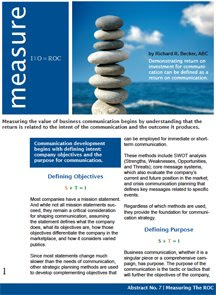
"In reality, there is only one flower. But inside a perceptual bubble, there may be three." — Richard Becker
While the foundation of public relations remains unchanged, the environment in which it operates is changing. In 20 years, mainstream media expanded from four channels to 4,000 channels and the Internet from a few sources to a seemingly infinite stream with an entire library of new content being added every second of the day.
Infinite Information Creates Miniature Realities.
While perception is a common theme here, it was Dan Schnur, a leading political and media strategist speaking at New Media and Political Campaigns, held in the Aurora Forum at Stanford University, who perhaps best articulated the concept that as information expands, the informational pools people draw upon shrink. For individuals, the danger becomes one of isolation, or as Schnur noted, people are drinking from completely different pools of information, which eventually creates different realities.
"As empowering as this media is, it's also isolating," said Schnur. "We have an array of not just three new programs at 6:30 at night, and not just five radio stations on our car radio, but when we have 800 cable TV, an infinite number of radio stations, and an even larger number of Web sites, blogs, and e-mail opportunities, it becomes much more easier for us to pick and choose who we talk to, what we talk about, and what we hear."
The outcome of this endless array of options affords us the opportunity to customize our information to such a degree, that we invent our own world view, which may be completely different from the world view of another person who made different choices. Schnur doesn't mean different opinions. He means different facts all together.
For example, if one person chooses Bill Maher, Daily Kos, and Media Matters, and another chooses Rush Limbaugh, Town Hall, and NewsBusters, both would develop opposing views of the new administraton, stimulus bill, and economic direction of the country. They would not just have different opinions, but an entirely different set of facts upon which to validate those opinions rather than drawing different conclusions based upon the same facts.
The outcome was made apparent last week after my post on fear communication, especially as it pertained to President Obama. In sharing the idea offline, two different people with polar political viewpoints had two different impressions of whether I was right about the communication. In fact, it took a recent affirmation from former President Clinton before that observation was even accepted by one of them.
The Danger of Validating Opinion.
The danger is two-fold. As people go to sources of information that validate what they believe instead of challenging them, the continuing transformation of media could further polarize perceptions as it aims to increase circulation by catering exclusively to that audience. Jonathan Alter, columnist and senior editor for Newsweek magazine, also at the Aurora Forum, recognized it as a troublesome trend.
"The definition of good journalism that I believe in [correct attribution: Finley Peter Dunne] comfort the afflicted and afflict the comfortable," said Alter. "The problem is that if the comfortable is not listening to you because you are not agreeing with them or comforting them, you get a different kind of journalism where you afflict the already afflicted and comfort the already comfortable."
The challenge becomes increasingly problematic because unpopular or even objective viewpoints become ignored, labeled as biased, or drowned out by diatribe. As individuals, and especially as communicators, it becomes especially important to drink from as diverse of information pools possible to maintain as broad of a world view as possible — accepting viewpoints that challenge us more than than validate our ideas.
The Challenge for Communication.
The challenge, especially as mainstream media struggles to adapt to a new market conditions, is that many publics may not be inclined to sample opinion outside their comfort zones. This creates an especially challenging environment for public relations because the trend is not isolated to politics.
Specifically, the challenge becomes applying a foundation that remains to some an increasingly diverse environment where two different people, living next door, could have as different realities as people living half a world away. It's at the heart of what Geoff Livingston called the "Communicators are in a perpetual losing battle for the attention of inundated minds." Except, it's not limited to advertising or communication. It applies to social media too. It only takes a click for consumers to unfollow.
Or to reframe the thought, take what Abraham Lincoln said — "Character is like a tree and reputation like its shadow. The shadow is what we think of it; the tree is the real thing." — and then recognize that people find trees uncomfortable.




















